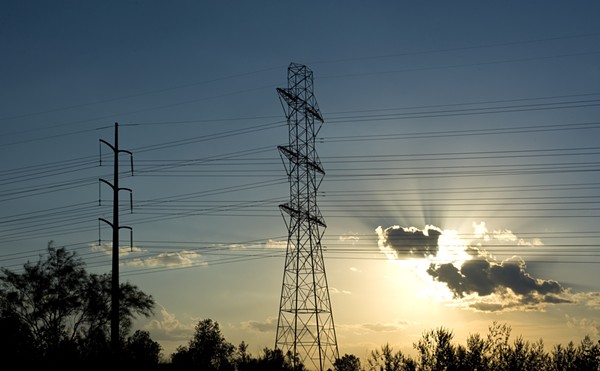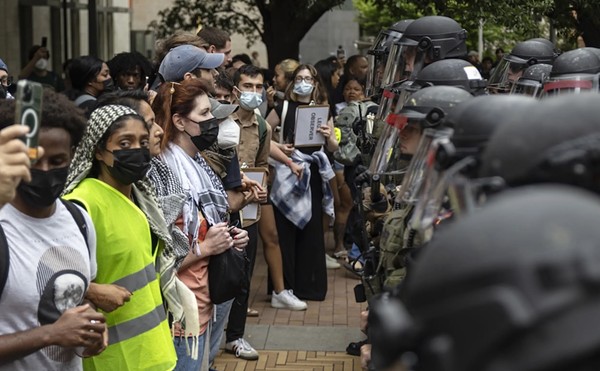It’s a gift: Hard numbers on CPS’s proposal to add two more nuclear plants to its electric-generating assembly. But it’s not coming from the City-owned utility.
CPS isn’t sharing its cost estimates with the public. However, an internationally respected energy expert contracted by an Austin-based non-profit rounded up his best figures for the two proposed plants and placed them neatly in the City’s lap last week. Original cost estimates by CPS partner NRG Energy of $7 billion for twin GE reactors add up to a $10 billion disagreement.
From the steps of City Hall last week, Karen Hadden, director of the Sustainable Energy and Economic Development (SEED) Coalition, urged council members look beyond the limited information the City-owned utility is offering.
“We want them to take their time to look at the real numbers — and Dr. Makhijani has been analyzing them — and to get the right information, because CPS Energy has a study, but they are not giving it to the public,” said Hadden. “That’s a great concern, because if they’re wrong and it
really costs more, who will pay for the bills? Who will pay for cost overruns? We’re afraid it will be the ratepayers.”
Council staff from Districts 1, 2, and 8, who met with Makhijani and Hadden failed to return phone calls this week, but it is likely our elected leaders aren’t insulated from the the current U.S. market jitters.
On top of a declining dollar, cost concerns over the expansion of South Texas Nuclear Project are understandable for two core reasons.
First, the city’s last investment in nuclear ran years behind schedule and five times over budget — from a proposed $974 million to an eventual $5.5 billion.
Secondly, the nuke industry in the U.S. has been at a dead stop for decades, making today’s recessionary economy even more daunting for the first new construction and operating permit filed in 29 years.
Then there’s the plant design.
“It’s never been built in the United States. Methods of contracting are different. Commodity prices are volatile,” said Mark Werner, CPS director of energy market operations.
Still, the site offers many advantages, Werner added, including built-in cooling-reserve capacity, a location already tailored for two more reactors, as well as the City’s own tax-exempt status.
For all that clarity, CPS won’t be sharing actual cost projections until construction agreements have been signed, Werner said. That could take until 2010 or 2011.
What official numbers are out have come from partner NRG Energy. Last summer, NRG officials announced the cost would be between $6 billion and $7 billion. Then, while NRG announced a new partnership with Toshiba last week, the figure was reported as $8 billion.
However, the announcement, which also included notice of a one-year delay in the project, according to a report by Wachovia Capital Markets, LLC, listed a new range of anticipated costs: $7.7 billion on the low end and $9.9 billion at the high. And Wachovia analysts found the high end “conservative,” adding: “We won’t be surprised if it rises further.”
Makhijani also would not be surprised. He expects the project costs to rise to at least $12 billion — and potentially as high as $17.5 billion — without factoring in future slides in the value of the dollar between now and whenever rates are locked in with a construction agreement. If CPS remains a 40-percent partner in future plants, that would put the city share between $4.8 billion and $7 billion.
Makhijani got his figures in part by observing the publicly released costs related to Florida Power & Light’s planned construction of two General Electric Advanced Boiling Water Reactors, the same units NRG/CPS has committed to. FP&L anticipates a cost range between $5,492 and $8,071 per kilowatt, compared with NRG’s recently revised $2,865 to $3,670 range. Even when you take out increased transmission and site-specific costs, San Antonio sheds only a few percent from FP&L’s total, Makhijani’s report states.
Makhijani also cites analysis by Wall Street’s credit-rating firm Moody’s. That group found “the all-in cost of a nuclear generating facility could come in at between $5,000 - $6,000/kw.”
Lanny Sinkin was one of the vocal few who fought CPS over plants 1 and 2 in the ’70s and ’80s. He’s particularly skeptical of the recently announced partnership between NRG and Toshiba, in which Toshiba becomes the principal contractor for STNP plants 3 and 4 for an investment of $300 million and a 12-percent equity stake.
“Contractors buying a percentage in the project … As the project becomes more valuable, the more the contract costs,” Sinkin said. “They’ve built in this conflict from the beginning.”
An NRG press agent last week pledged to put the Current in touch with company experts to answer our financial questions, but after several days had failed to call back.
Sinkin said there are several differences between the first round of STNP nuke plants being built and the current push.
“Alternatives are far more developed,” he said. “We couldn’t really talk about solar and efficiency and wind and biomass back in the ’70s and ’80s. Now it’s a whole different thing. Now, if you’re not working with these technologies you’re falling behind the curve.”
NRG is keeping a hand in the wind-energy wave in Texas, though, launching construction last week of a 122-megawatt wind farm in Howard County, expected to be completed by year’s end. The company is also involved in a carbon-capture project at an East Texas coal plant.
Another difference Sinkin notes is that plants 1 and 2 “were a done deal before it got out of CPS. The city council was just irrelevant.”
How relevant Council chooses to be this round — with their first vote on a requested $206 million to get in the nuclear game expected this summer — is still a wide-open question. •
WEB EXTRA
Critics of CPS’s proposed nuclear path lined up to blast the board at last week’s public hearing on the utility’s proposed rate hike.
Monday morning, the board approved the hike of about five percent, though took no action on its Strategic Energy Plan after meeting in executive session on the matter.


















